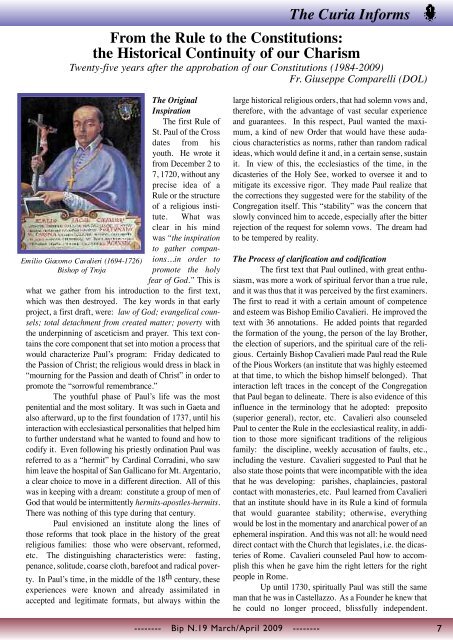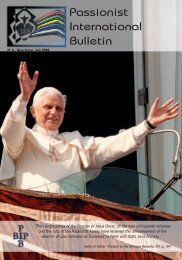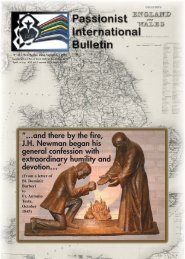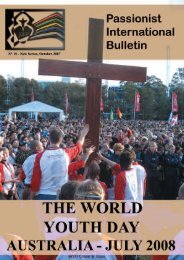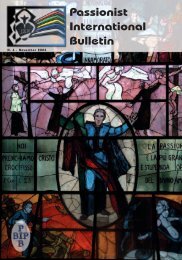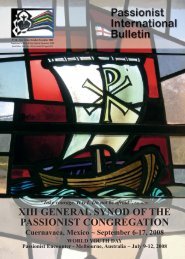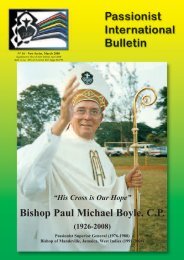The Curia Informs - Passio Christi
The Curia Informs - Passio Christi
The Curia Informs - Passio Christi
You also want an ePaper? Increase the reach of your titles
YUMPU automatically turns print PDFs into web optimized ePapers that Google loves.
<strong>The</strong> <strong>Curia</strong> <strong>Informs</strong><br />
From the Rule to the Constitutions:<br />
the Historical Continuity of our Charism<br />
Twenty-five years after the approbation of our Constitutions (1984-2009)<br />
Fr. Giuseppe Comparelli (DOL)<br />
Emilio Giacomo Cavalieri (1694-1726)<br />
Bishop of Troja<br />
<strong>The</strong> Original<br />
Inspiration<br />
<strong>The</strong> first Rule of<br />
St. Paul of the Cross<br />
dates from his<br />
youth. He wrote it<br />
from December 2 to<br />
7, 1720, without any<br />
precise idea of a<br />
Rule or the structure<br />
of a religious institute.<br />
What was<br />
clear in his mind<br />
was “the inspiration<br />
to gather companions…in<br />
order to<br />
promote the holy<br />
fear of God.” This is<br />
what we gather from his introduction to the first text,<br />
which was then destroyed. <strong>The</strong> key words in that early<br />
project, a first draft, were: law of God; evangelical counsels;<br />
total detachment from created matter; poverty with<br />
the underpinning of asceticism and prayer. This text contains<br />
the core component that set into motion a process that<br />
would characterize Paul’s program: Friday dedicated to<br />
the <strong>Passio</strong>n of Christ; the religious would dress in black in<br />
“mourning for the <strong>Passio</strong>n and death of Christ” in order to<br />
promote the “sorrowful remembrance.”<br />
<strong>The</strong> youthful phase of Paul’s life was the most<br />
penitential and the most solitary. It was such in Gaeta and<br />
also afterward, up to the first foundation of 1737, until his<br />
interaction with ecclesiastical personalities that helped him<br />
to further understand what he wanted to found and how to<br />
codify it. Even following his priestly ordination Paul was<br />
referred to as a “hermit” by Cardinal Corradini, who saw<br />
him leave the hospital of San Gallicano for Mt. Argentario,<br />
a clear choice to move in a different direction. All of this<br />
was in keeping with a dream: constitute a group of men of<br />
God that would be intermittently hermits-apostles-hermits.<br />
<strong>The</strong>re was nothing of this type during that century.<br />
Paul envisioned an institute along the lines of<br />
those reforms that took place in the history of the great<br />
religious families: those who were observant, reformed,<br />
etc. <strong>The</strong> distinguishing characteristics were: fasting,<br />
penance, solitude, coarse cloth, barefoot and radical poverty.<br />
In Paul’s time, in the middle of the 18 th century, these<br />
experiences were known and already assimilated in<br />
accepted and legitimate formats, but always within the<br />
large historical religious orders, that had solemn vows and,<br />
therefore, with the advantage of vast secular experience<br />
and guarantees. In this respect, Paul wanted the maximum,<br />
a kind of new Order that would have these audacious<br />
characteristics as norms, rather than random radical<br />
ideas, which would define it and, in a certain sense, sustain<br />
it. In view of this, the ecclesiastics of the time, in the<br />
dicasteries of the Holy See, worked to oversee it and to<br />
mitigate its excessive rigor. <strong>The</strong>y made Paul realize that<br />
the corrections they suggested were for the stability of the<br />
Congregation itself. This “stability” was the concern that<br />
slowly convinced him to accede, especially after the bitter<br />
rejection of the request for solemn vows. <strong>The</strong> dream had<br />
to be tempered by reality.<br />
<strong>The</strong> Process of clarification and codification<br />
<strong>The</strong> first text that Paul outlined, with great enthusiasm,<br />
was more a work of spiritual fervor than a true rule,<br />
and it was thus that it was perceived by the first examiners.<br />
<strong>The</strong> first to read it with a certain amount of competence<br />
and esteem was Bishop Emilio Cavalieri. He improved the<br />
text with 36 annotations. He added points that regarded<br />
the formation of the young, the person of the lay Brother,<br />
the election of superiors, and the spiritual care of the religious.<br />
Certainly Bishop Cavalieri made Paul read the Rule<br />
of the Pious Workers (an institute that was highly esteemed<br />
at that time, to which the bishop himself belonged). That<br />
interaction left traces in the concept of the Congregation<br />
that Paul began to delineate. <strong>The</strong>re is also evidence of this<br />
influence in the terminology that he adopted: preposito<br />
(superior general), rector, etc. Cavalieri also counseled<br />
Paul to center the Rule in the ecclesiastical reality, in addition<br />
to those more significant traditions of the religious<br />
family: the discipline, weekly accusation of faults, etc.,<br />
including the vesture. Cavalieri suggested to Paul that he<br />
also state those points that were incompatible with the idea<br />
that he was developing: parishes, chaplaincies, pastoral<br />
contact with monasteries, etc. Paul learned from Cavalieri<br />
that an institute should have in its Rule a kind of formula<br />
that would guarantee stability; otherwise, everything<br />
would be lost in the momentary and anarchical power of an<br />
ephemeral inspiration. And this was not all: he would need<br />
direct contact with the Church that legislates, i.e. the dicasteries<br />
of Rome. Cavalieri counseled Paul how to accomplish<br />
this when he gave him the right letters for the right<br />
people in Rome.<br />
Up until 1730, spiritually Paul was still the same<br />
man that he was in Castellazzo. As a Founder he knew that<br />
he could no longer proceed, blissfully independent.<br />
-------- Bip N.19 March/April 2009 -------- 7


